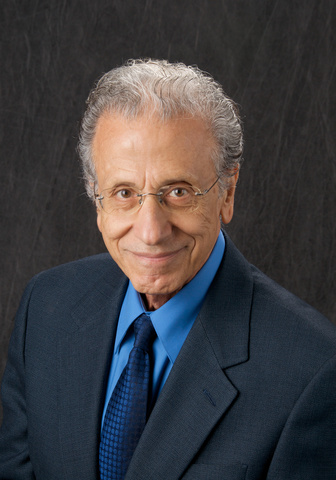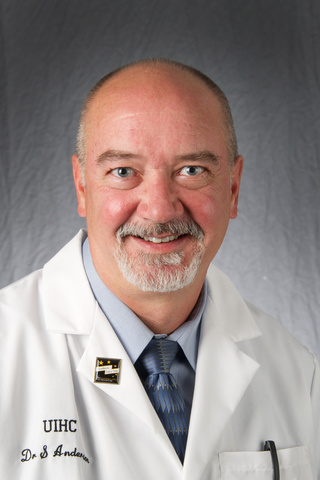Celebrating Impactful Published Research
The University of Iowa Roy J. and Lucille A. Carver College of Medicine Wall of Scholarship was established to highlight biomedical research by acknowledging a distinct group of Carver College of Medicine faculty members whose published research articles have made a significant impact on a particular field of science or medicine.
Plaques for six peer-reviewed research articles, for which five current Carver College of Medicine faculty members served as first or senior authors, will be added to the Wall of Scholarship in 2020. A total of 38 plaques, representing the work of 24 faculty members, are displayed on the Wall of Scholarship.
The articles were selected for having been cited more than 1,000 times in subsequent published research articles, based on at least two of three recognized academic citation indices: Google Scholar, Scopus, and Web of Science. As additional first- or senior-authored research papers by Carver College of Medicine faculty achieve the distinction of 1,000 citations, these scholarly works will be commemorated with plaques on the Wall of Scholarship.
Event details
Wednesday, Feb. 12, 2020
4 p.m.
Eckstein Medical Research Building Atrium
2020 Inductees
 Francois M. Abboud, MD, MACP
Francois M. Abboud, MD, MACP

- Associate Vice President for Research
- Professor, Department of Internal Medicine – Cardiovascular Medicine
- Professor of Molecular Physiology and Biophysics
- Founding Director, University of Iowa Francois M. Abboud Cardiovascular Research Center
- Edith King Pearson Chair of Cardiovascular Research
Publication
“Sympathetic nerve activity during sleep in normal subjects.” New England Journal of Medicine. 1993 Feb 4;328(5):303-7.
Research article summary
Sympathetic nervous system activity is increased during events that increase cardiovascular stress during heart attacks and strokes. The early morning hours after awakening are associated with such higher-than-expected, and potentially fatal, events.
Abboud and colleagues were first to measure sympathetic nerve activity in humans during sleep. Whereas the activity declined during the early phases of sleep, it was increased during rapid eye movement (REM), which manifests most toward the end of sleep. During REM sleep the brain is very active while voluntary muscles are inactive, as if paralyzed. This excessive nerve activity during REM sleep could conceivably initiate increased platelet aggregation, blood clots, or coronary vasospasm or strokes that may present only after arousal. Studies aimed at understanding the brain events during REM sleep will reduce cardiovascular mortality.
Abboud has held key leadership positions in the Carver College of Medicine—including 26 years as chair and departmental executive officer of the Department of Internal Medicine—while leading advances in cardiovascular disease and stroke. His honors include the George M. Kober Medal from the Association of American Physicians and memberships in the National Academy of Medicine and the American Academy of Arts and Sciences. Abboud has served as president of the American Heart Association, Association of American Physicians, American Clinical and Climatological Association, Central Society for Clinical Research, and the American Federation for Clinical Research.
 Steven Anderson, PhD
Steven Anderson, PhD

- Associate Professor, Department of Neurology
Publications
“Insensitivity to future consequences following damage to human prefrontal cortex.” Cognition. 1994 Apr-Jun;50(1-3):7-15
“Impairment of social and moral behavior related to early damage in the human prefrontal cortex.” Nature Neuroscience. 1999 Nov;2(11):1032-7
Research article summary
In the Cognition paper, Anderson and colleagues Antoine Bechara, PhD, Antonio Damasio, MD, PhD, and Hanna Damasio, MD, described the development of a new laboratory test that for the first time captured the decision-making impairments that result from damage to the human ventromedial prefrontal cortex. The finding of disadvantageous decision-making, which was guided by immediate prospects while ignoring long-term consequences, provided a new understanding of the cognitive mechanisms underlying these patients’ real-world difficulties and provided a new tool for clinical evaluation and laboratory investigation.
In the Nature Neuroscience paper, Anderson and colleagues (Bechara, Damasio, Damasio, and Daniel Tranel, PhD) described the long-term consequences of circumscribed damage to the prefrontal cortex in the first months of life. The finding of impaired social-moral behavior and social reasoning, together with defective autonomic responses to punishment, demonstrated the critical role of the prefrontal cortex in the development of social behavior and its potential involvement in developmental behavior disorders.
Anderson’s general field of study is cognitive neuroscience and clinical neuropsychology. His research focuses on understanding the cognitive, behavioral, and emotional consequences of brain injury and disease.
 Aloysius Klingelhutz, PhD
Aloysius Klingelhutz, PhD

- Professor, Department of Microbiology and Immunology
- Professor, Department of Radiation Oncology
Publication
“Both Rb/p16INK4a inactivation and telomerase activity are required to immortalize human epithelial cells.” Nature. Nov 5;396(6706):84-8.
Research article summary
In the Nature paper, Klingelhutz and colleagues defined what steps are needed to make human epithelial cells immortal—a process that is required for the development of cancer. It was discovered that both activation of telomerase, an enzyme that lengthens the DNA repeats at the ends of chromosomes, and inactivation of a cell cycle checkpoint pathway were necessary to overcome an internal program that causes cells to senesce, or deteriorate with age. These results have had significant implications for cancer and aging research.
Klingelhutz’s expertise in cell immortalization and cell culture techniques has allowed his laboratory to develop sophisticated cell culture models that recapitulate human tissue for research. His lab now has broad interests in how viruses infect and disseminate in skin and how microbial and environmental factors affect adipose tissue to cause metabolic syndrome.
Klingelhutz’s education and training program affiliations include the Free Radical and Radiation Biology Graduate Program, the Interdisciplinary Graduate Program in Genetics, the Interdisciplinary Graduate Program in Human Toxicology, and Interdisciplinary Program in Molecular Medicine. He also teaches and mentors students for the undergraduate major in microbiology. His research affiliations include the Fraternal Order of Eagles Diabetes Research Center, the Helen C. Levitt Center for Viral Pathogenesis, and the UI Holden Comprehensive Cancer Center.
 Marc Wold, PhD
Marc Wold, PhD

- Professor, Department of Biochemistry
- Professor, Department of Radiation Oncology
Publication
“Replication protein A: a heterotrimeric, single-stranded DNA-binding protein required for eukaryotic DNA metabolism.” Annual Review of Biochemistry. 1997;66:61-92.
Research article summary
The human genome is composed of approximately 3 billion base pairs of DNA. In order to grow, a human cell must precisely duplicate this entire genome each cell cycle and continuously protect it from damage or modification. Defects in DNA replication or repair result in higher rates of mutation and chromosome instability and can have a direct role in a number of human diseases—contributing to the development of cancer or genetic diseases such as fragile X syndrome and xeroderma pigmentosum.
Replication protein A (RPA) is a multi-functional, single-stranded DNA-binding protein that is essential to maintaining the integrity of the human genome. RPA binds to single-stranded DNA-intermediates during DNA replication and repair and causes them to be efficiently processed. Wold was one of the co-discoverers of RPA in 1988 and played a central role in defining the properties and functions of RPA in human cells. Wold’s laboratory at Iowa carried out much of the initial characterization of RPA. The Annual Review of Biochemistry article was the first comprehensive review of RPA and continues to serve as a seminal resource on this protein.
Wold’s research focuses on understanding the mechanisms and regulation of DNA replication and repair in human cells. His current research is focused on understanding how dynamic protein interactions coordinate DNA replication and repair, and the role of a primate-specific RPA variant in human disease. Wold’s education and training program affiliations include the Free Radical and Radiation Biology Graduate Program and the Medical Scientist Training Program. He also is a research member of the UI Holden Comprehensive Cancer Center.
 Mark Yorek, PhD
Mark Yorek, PhD

- Professor, Department of Internal Medicine – Endocrinology and Metabolism
- Associate Chief of Staff for Research, Iowa City Veterans Affairs Medical Center
Publication
“Membrane lipid composition and cellular function.” Journal of Lipid Research. 1985 Sep;26(9):1015-35
Research article summary
In the Journal of Lipid Research review article, Yorek, along with colleague Arthur A. Spector, MD, provided a comprehensive analysis of the effect of fatty acids on membrane structure and function. The impetus for this article came from studies ongoing in the laboratory that demonstrated that enriching mammalian cells with omega-3 polyunsaturated fatty acids, which are fatty acids derived from fish oil, significantly increased membrane fluidity and altered the structure of membrane phospholipids. These studies were primarily preformed using neural cells and showed that exposing the cells to omega-3 polyunsaturated fatty acids also changed cell function, including the binding of insulin to its receptor on the cell membrane.
Yorek’s research focuses primarily on understanding the cause of neural and vascular dysfunction caused by obesity and diabetes. Building upon his earlier research on omega-3 polyunsaturated fatty acids, the Yorek laboratory currently is designing studies to translate their work that over the past few years has shown that fatty acids derived from fish oil are a potentially safe and effective treatment for diabetic peripheral neuropathy.